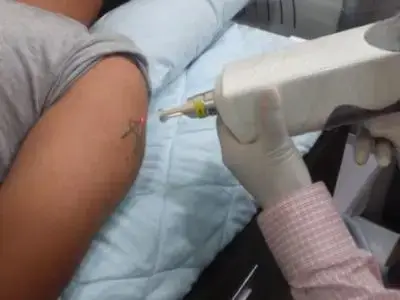What is Laser Tattoo Removal?
Laser tattoo removal is a non-invasive procedure that uses high-intensity laser beams to break down tattoo pigments into smaller particles. These particles are then gradually eliminated by the body’s immune system. The effectiveness of the treatment depends on various factors, including the tattoo’s color, size, and location, as well as the individual’s skin type.
Types of Lasers Used in Permanent Tattoo Removal
Different laser wavelengths are utilized to target specific tattoo colors:
- Q-Switched Nd:Yag Laser (1064 nm): Effective for removing dark black and blue tattoos, especially on darker skin tones.
- Q-Switched Alexandrite Laser (755 nm): Targets dark black and blue tattoos on lighter skin tones.
- Q-Switched Nd:Yag Laser (532 nm): Best for red ink tattoos on light skin.
- Q-Switched Ruby Laser (694 nm): Optimal for green ink tattoos on lighter skin.
Multicolored tattoos require treatment with lasers of different wavelengths, each targeting specific ink colors.
Time Required for Complete Tattoo Removal with Laser
The number of sessions and the overall duration required for complete tattoo removal can vary based on several factors, including:
- Skin Type: Different skin types respond differently to laser treatment.
- Location: Tattoos in areas with better blood circulation may fade faster.
- Tattoo Characteristics:
- Age (How old is the tattoo)
- Older Tattoos: Generally, older tattoos may be easier to remove because the ink may have faded over time, allowing the laser to target the remaining pigment more effectively.
- Newer Tattoos: Newer tattoos are often darker and more saturated, which can make them harder to remove completely.
- Size
- Smaller Tattoos: Smaller tattoos typically require fewer sessions to remove, as there is less ink to break down.
- Larger Tattoos: Larger tattoos may take more sessions and a longer overall duration for complete removal due to the increased amount of ink.
- Color
- Dark Colors: Darker inks, like black or dark blue, tend to absorb laser energy better, making them easier to remove.
- Light Colors: Lighter colors, such as yellow or green, may not respond as well to certain laser wavelengths, potentially requiring more sessions.
- Depth
- Superficial Tattoos: Tattoos that are closer to the skin’s surface are usually easier to remove, as the laser can more effectively target the ink.
- Deep Tattoos: Tattoos that penetrate deeper layers of skin may require more sessions, as the ink particles are harder to reach and break down.
- Age (How old is the tattoo)
Typically, multiple sessions spaced several weeks apart are necessary. It may take several months, or even more than a year, to completely remove a tattoo. It’s important to have realistic expectations, as complete removal may not be possible in all cases.
Safety and Side Effects
When performed by a qualified professional, laser tattoo removal is generally safe. However, there are some potential side effects, including:
- Initial Skin Reactions: Mild skin whitening, bleeding, swelling, tenderness, and redness may occur but typically resolve within two to three days.
- Blistering: Blisters may develop within 24 hours of treatment. While they can sometimes be large, they generally heal within a week or slightly longer.
- Pigmentation Changes: Some patients might experience changes in skin pigmentation, resulting in darker (hyperpigmentation) or lighter (hypopigmentation) areas. These changes usually resolve naturally over time.
- Scarring: There is a potential risk of scarring associated with laser tattoo removal.
Following proper aftercare guidelines provided by your dermatologist can help minimize these risks.
Things to Do Before and After Treatment
Before Undergoing Laser Tattoo Removal:
- Consult a Professional: Seek advice from a dermatologist to evaluate your suitability for the procedure.
- Avoid Sun Exposure: Limit sun exposure to the area to be treated for at least a week prior to the session.
- Follow Pre-Treatment Instructions: Adhere to any specific guidelines provided by your dermatologist to ensure optimal preparation for the treatment.
After Undergoing Laser Tattoo Removal:
- Avoid Sun Exposure: Continue to limit sun exposure to the treated area for at least a week after the treatment.
- Follow Aftercare Instructions: Adhere to your dermatologist’s advice and apply any prescribed medications as directed to promote optimal healing.
